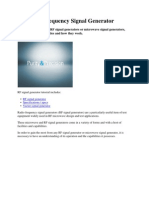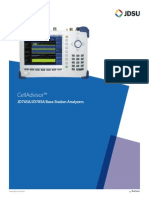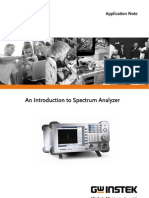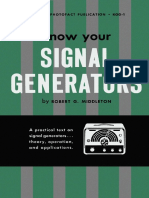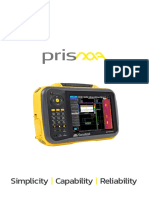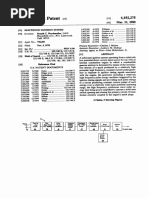Function Generator
Uploaded by
bhayyaupwalaFunction Generator
Uploaded by
bhayyaupwalaDEPARTMENT OF PHYSICS
MAR THOMA COLLEGE FOR WOMEN, PERUMBAVOOR
FUNCTION GENERATOR
A function generator is a type of electronic test equipment used in various fields, including
electronics, engineering, and physics. It is designed to produce precise and controllable
electrical waveforms, such as sine waves, square waves, triangular waves, and more. Here are
some key points about function generators:
1. Waveform Generation: Function generators can produce a variety of waveforms, including
sinusoidal (sine), square, triangular, sawtooth, and arbitrary waveforms. The ability to generate
different waveforms is useful for testing and troubleshooting electronic circuits.
2. Frequency Control: Users can adjust the frequency of the output signal over a wide range,
typically from a fraction of a hertz to several megahertz. This flexibility is valuable for
applications ranging from audio testing to high-frequency RF (Radio Frequency) testing.
3. Amplitude Control: Function generators allow users to control the amplitude or voltage level
of the output signal. This is important for setting the desired signal strength for specific
applications.
4.Duty Cycle Control: For square waveforms, function generators provide control over the duty
cycle, which is the ratio of time the signal is high to the total period. This is useful for generating
signals with specific pulse widths.
5. Modulation Capabilities: Some advanced function generators support modulation techniques
like amplitude modulation (AM), frequency modulation (FM), and phase modulation (PM).
These are often used in communications testing.
Function Generator Department of Physics, MTCW
DEPARTMENT OF PHYSICS
MAR THOMA COLLEGE FOR WOMEN, PERUMBAVOOR
6.Arbitrary Waveform Generation: In addition to standard waveforms, some function
generators can create custom or arbitrary waveforms defined by the user. This is beneficial for
emulating real-world signals or specific test scenarios.
7.Synchronization and Triggering: Function generators often provide synchronization and
triggering options, allowing them to be synchronized with other test equipment or external
signals for precise timing.
8.Applications: Function generators are used in various applications, including signal testing
and calibration, circuit prototyping, audio and RF signal generation, and educational purposes.
9.Accuracy and Precision: High-quality function generators offer precise control over
frequency and amplitude, with low distortion and signal purity.
10.Output Interface: Function generators typically have various output interfaces, such as BNC
connectors for connecting to other equipment or devices.
Function generators are essential tools in electronics laboratories, production environments,
and research facilities for generating and testing electrical signals under controlled conditions.
They are valuable for characterizing and troubleshooting electronic circuits, as well as for
developing and verifying the performance of electronic devices and systems.
Function Generator Department of Physics, MTCW
You might also like
- UNIT-4 Power Quality Monitoring: Terms and Definitions Spectrum AnalyzerNo ratings yetUNIT-4 Power Quality Monitoring: Terms and Definitions Spectrum Analyzer9 pages
- Conditioning and Correction of Arbitrary Waveforms - Part 1: DistortionNo ratings yetConditioning and Correction of Arbitrary Waveforms - Part 1: Distortion7 pages
- Presented By,: 1) Garad Ganesh Shahuraj 2) Jadhav Hemant SampatNo ratings yetPresented By,: 1) Garad Ganesh Shahuraj 2) Jadhav Hemant Sampat68 pages
- Unit-III-Signal Generators & Wave Analyzers PDF100% (1)Unit-III-Signal Generators & Wave Analyzers PDF33 pages
- Jawaharlal Nehru Engineering College: Laboratory ManualNo ratings yetJawaharlal Nehru Engineering College: Laboratory Manual33 pages
- Transformer Winding Deformation Tester ManualNo ratings yetTransformer Winding Deformation Tester Manual38 pages
- Structure-Functional Schemes of Wide-Range Frequency Multipliers of Sampled Harmonic SignalsNo ratings yetStructure-Functional Schemes of Wide-Range Frequency Multipliers of Sampled Harmonic Signals4 pages
- Functions and Signal Generators: EE205 - Term ProjectNo ratings yetFunctions and Signal Generators: EE205 - Term Project12 pages
- Informe de Laboratorio 1: Santiago Alberto Ramírez MarínNo ratings yetInforme de Laboratorio 1: Santiago Alberto Ramírez Marín7 pages
- Measurement Vibrations and Radiated Acoustic Noise of Electrical MachinesNo ratings yetMeasurement Vibrations and Radiated Acoustic Noise of Electrical Machines6 pages
- Linear Circuit Analysis Lab Manual BeeeNo ratings yetLinear Circuit Analysis Lab Manual Beee60 pages
- WEEK 2 MODULE 2 - Process Instrumentation - EditedNo ratings yetWEEK 2 MODULE 2 - Process Instrumentation - Edited71 pages
- Function Generator and Signal GeneratorNo ratings yetFunction Generator and Signal Generator18 pages
- Know Your Signal Generators - Robert G. Middleton100% (1)Know Your Signal Generators - Robert G. Middleton145 pages
- CHE 510: Process Control & Instrumentation: Department of Chemical Engineering Obafemi Awolowo UniversityNo ratings yetCHE 510: Process Control & Instrumentation: Department of Chemical Engineering Obafemi Awolowo University73 pages
- 2010 - Zz-Modal Parameter Identification of Stay Cables From Output-Only Measurements-2010No ratings yet2010 - Zz-Modal Parameter Identification of Stay Cables From Output-Only Measurements-201018 pages
- Design_Implementation_and_Evaluation_of_Proficiency_Testing_in_EMC_Burst_Immunity2024No ratings yetDesign_Implementation_and_Evaluation_of_Proficiency_Testing_in_EMC_Burst_Immunity20247 pages
- Power Quality Laboratory Testing: Ward JewellNo ratings yetPower Quality Laboratory Testing: Ward Jewell3 pages
- Function Generator: Electronic Test InstrumentNo ratings yetFunction Generator: Electronic Test Instrument6 pages
- (FREE PDF Sample) RF and Microwave Handbook RF and Microwave Applications and Systems 1st Edition Mike Golio Ebooks100% (6)(FREE PDF Sample) RF and Microwave Handbook RF and Microwave Applications and Systems 1st Edition Mike Golio Ebooks70 pages
- Shock and Vibration - 2021 - Mohd Ghazali - Vibration Analysis for Machine Monitoring and Diagnosis a Systematic ReviewNo ratings yetShock and Vibration - 2021 - Mohd Ghazali - Vibration Analysis for Machine Monitoring and Diagnosis a Systematic Review25 pages
- Chapter 1 - Introduction To Automotive Electrical and Electronic SystemNo ratings yetChapter 1 - Introduction To Automotive Electrical and Electronic System26 pages
- K HB 020EN - Bedside Terminals - Product Catalogue 2014 - V1.4No ratings yetK HB 020EN - Bedside Terminals - Product Catalogue 2014 - V1.430 pages
- Power Law Filters A New Class of Fractional - 2021 - AEU - International JournNo ratings yetPower Law Filters A New Class of Fractional - 2021 - AEU - International Journ13 pages
- Request For Quotation Local Purchase Section: RFQ NumberNo ratings yetRequest For Quotation Local Purchase Section: RFQ Number13 pages
- Audio Video and Media: Module2: Electro Acoustical Transducers, Equalization and FiltersNo ratings yetAudio Video and Media: Module2: Electro Acoustical Transducers, Equalization and Filters16 pages
- Cts6U: 6 SQ - MM Standard Feed Through Terminal BlocksNo ratings yetCts6U: 6 SQ - MM Standard Feed Through Terminal Blocks3 pages
- Analog Digital Electronics (ADE) - Sequential CircuitsNo ratings yetAnalog Digital Electronics (ADE) - Sequential Circuits33 pages
- Comparison Between AM, PM and FM: Term Paper OnNo ratings yetComparison Between AM, PM and FM: Term Paper On20 pages
- Iris Power Stator Wedge Analyzer SWA BrochureNo ratings yetIris Power Stator Wedge Analyzer SWA Brochure2 pages
















